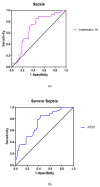Can Coagulation System Disorders and Cytokine and Inflammatory Marker Levels Predict the Temporary Clinical Deterioration or Improvement of Septic Patients on ICU Admission?
- PMID: 33917002
- PMCID: PMC8067680
- DOI: 10.3390/jcm10081548
Can Coagulation System Disorders and Cytokine and Inflammatory Marker Levels Predict the Temporary Clinical Deterioration or Improvement of Septic Patients on ICU Admission?
Abstract
Although coagulation disorders and immune/inflammatory response have been associated with the final outcome of patients with sepsis, their link with thetemporaryclinical deterioration or improvement of patients is unknown. We aimed to investigate this link. We prospectively included consecutive patients admitted to the intensive care unit (ICU) with a suspected diagnosis of infection and evaluated within the first 24 h from admission. Blood levels of many cytokines and inflammatory and coagulation factors were measured and their predictive value was assessed by calculating the Area Under the Receiver Operating Characteristic (AUROC) curves. Patients (n = 102) were allocated in five groups, i.e., sepsis (n = 14), severe sepsis (n = 17), septic shock (n = 28), Systemic Inflammatory Response Syndrome (SIRS) without infection (n = 17), and trauma/surgery without SIRS or infection (n = 26). In septic shock, coagulation factors FVII and FIX and Protein C had AUROCs 0.67-0.78. In severe sepsis, Antithrombin III, Protein C, C-reactive protein, Procalcitonin and Thrombopoietin had AUROCs 0.73-0.75. In sepsis, Tumor Necrosis Factor a, and Interleukins 1β and 10 had AUROCs 0.66-0.72. In patients admitted to the ICU with a suspected diagnosis of infection, coagulation factors and inhibitors, as well as cytokine and inflammatory marker levels, have substantial predictive value in distinct groups of septic patients.
Keywords: antithrombin III; coagulation; coagulation inhibitors; cytokines; procalcitonin; protein C; sepsis; septicshock; thrombopoietin.
Conflict of interest statement
The authors declare no conflict of interest.
Figures


Similar articles
-
[Changes in plasma interleukin-33 concentration in sepsis and its correlation with seriousness of sepsis].Zhonghua Wei Zhong Bing Ji Jiu Yi Xue. 2015 Feb;27(2):138-42. doi: 10.3760/cma.j.issn.2095-4352.2015.02.012. Zhonghua Wei Zhong Bing Ji Jiu Yi Xue. 2015. PMID: 25665614 Chinese.
-
[Diagnostic value of serum procalcitonin for infection in the immunocompromised critically ill patients with suspected infection].Zhonghua Wei Zhong Bing Ji Jiu Yi Xue. 2015 Jun;27(6):477-83. doi: 10.3760/cma.j.issn.2095-4352.2015.06.012. Zhonghua Wei Zhong Bing Ji Jiu Yi Xue. 2015. PMID: 26049187 Chinese.
-
Assessment of Clinical Criteria for Sepsis: For the Third International Consensus Definitions for Sepsis and Septic Shock (Sepsis-3).JAMA. 2016 Feb 23;315(8):762-74. doi: 10.1001/jama.2016.0288. JAMA. 2016. PMID: 26903335 Free PMC article.
-
The epidemiology of the systemic inflammatory response.Intensive Care Med. 2000;26 Suppl 1(Suppl 1):S64-74. doi: 10.1007/s001340051121. Intensive Care Med. 2000. PMID: 10786961 Free PMC article. Review.
-
[[Antithrombin III concentrates in the treatmetn of sepsis and septic shock: indictions, limits and future prospects] ].Minerva Anestesiol. 2000 Nov;66(11 Suppl 1):3-23. Minerva Anestesiol. 2000. PMID: 11213542 Review. Italian.
Cited by
-
Coagulation Factor XII Is an Antibacterial Protein That Acts Against Bacterial Infection via Its Heavy Chain.Int J Mol Sci. 2025 Jun 23;26(13):6009. doi: 10.3390/ijms26136009. Int J Mol Sci. 2025. PMID: 40649792 Free PMC article.
References
-
- Dellinger R.P., Carlet J.M., Masur H., Gerlach H., Calandra T., Cohen J., Gea-Banacloche J., Keh D., Marshall J.C., Parker M.M., et al. Surviving Sepsis Campaign guidelines for management of severe sepsis and septic shock. Crit. Care Med. 2004;32:858–873. doi: 10.1097/01.CCM.0000117317.18092.E4. - DOI - PubMed
LinkOut - more resources
Full Text Sources
Other Literature Sources
Research Materials

